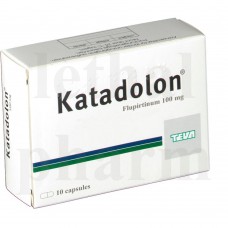Expiration date: 04/2026
Active substance: Flupirtine
Pharmacokinetics:
After oral administration, the drug is rapidly and almost completely (90%) absorbed from the gastrointestinal tract. Up to 75% of the dose is metabolized in the liver with the formation of metabolites M1 and M2. Active metabolite M1 (2-amino-3-acetamino-6- [4-fluoro] -benzilaminopiridin) formed by hydrolysis of the urethane structures (1st phase reaction) and subsequent acetylation (2nd reaction stage) and provides an average of 25 % analgesic activity of flupirtine. Another metabolite M2 is not biologically active, formed by the oxidation reaction (1st phase) of p-fluorobenzyl followed by conjugation (Phase 2) of p-fluorobenzoic acid glycine.
T1 / 2 of the drug from plasma is about 7 hours (10 hours for the base substance and metabolite M1), which is sufficient to provide an analgesic effect.
The concentration of active substance in the blood plasma is proportional to dose. In the elderly (over 65 years) compared to young patients an increase in T1 / 2 (up to 14 hours and at a single dose to 18.6 hours when administered within 12 days) and Cmax of the drug in the blood plasma, respectively, 2- 2.5 times higher.
For the most part excreted by the kidneys (69%): 27% - unchanged, 28% - in the form of the M1 metabolite (acetyl metabolite), 12% - in the form of the M2 metabolite (para-ftorgippurovaya acid) 1/3 of the administered dose is excreted as metabolites of unknown structure. A small part of the dose excreted in the bile and feces.
Description of the pharmacological actions:
Flupirtine is representative of a class of drugs - selective neuronal potassium channel activators (Selective Neuronal Potassium Channel Opener - SNEPCO). According to its pharmacological effect of the drug is a non-opioid analgesic central action, which does not cause dependency and addiction, in addition, has a muscle relaxant and neuroprotective effect. The action is based on flupirtine potentsialnezavisimyh activation of potassium channels, which leads to stabilization of the membrane potential of the neuron. Effects on the potassium ion current mediated regulatory action of the drug on the G-protein system. Analgesic activity based on indirect antagonism both in relation to the NMDA (N-metil-D-aspartat) -petseptoram, and the modulation of pain mechanisms related to the effects on the GABA system.
At therapeutic concentrations, flupirtine does not bind to alpha 1, alpha 2-adrenergic receptors, serotonin 5NT1-, 5HT2 receptors, dopaminergic, benzodiazepine, opiate, central muskarinergicheskimi or nikotinergicheskimi receptors.
The central action of flupirtine is based on 3 main effects:
analgesic effect
Flupirtine activates (opens) potentsialnezavisimye potassium channels, which leads to stabilization of the membrane potential of nerve cells. Thus there is an inhibition of the NMDA-receptor, and as a result, blockage of neuronal calcium ion channels, reducing the intracellular calcium ion current. Due to the growing suppression of neuronal excitation in response to nociceptive stimuli, inhibiting the activation of nociceptive realized analgesic effect. This results in inhibition of the growth of the neuronal response to repeated painful stimuli. This action prevents the amplification of pain and its transition into a chronic form, and with already existing chronic pain tends to reduce its intensity. It was also established modulating effect of flupirtine on the perception of pain through descending noradrenergic system.
muscle relaxation action
Antispasmodic effect on the muscle to block the transfer of excitation in the motor neurons of the intermediate neurons, leading to the removal of muscle tension. This action of flupirtine is manifested in many chronic diseases accompanied by painful muscle spasms (musculoskeletal pain in the neck and back pain, arthropathy, tenzionnye headaches, fibromyalgia).
neuroprotection
Neuroprotective properties of the drug are responsible for the protection of the nervous structures of the toxic effect of high concentrations of intracellular calcium ions, which is due to its ability to cause a blockade of neuronal ionic calcium channels and lower intracellular calcium ion current.
Testimony:
Acute and chronic pain in the following conditions:
- muscle spasms (musculoskeletal pain in the neck and back pain, arthropathy, fibromyalgia)
- headache
- malignant neoplasms
- dysmenorrhea
- post-traumatic pain
- pain in trauma / orthopedic surgery and interventions.
Contraindications:
- Hypersensitivity to the active substance or to any other component of the drug
- history of liver disease
- cholestasia
- severe myasthenia gravis
- alcoholism
- ringing in the ears (including the recently healed)
- pregnancy
- lactation
- Children up to age 18 years.
Precautions: hepatic dysfunction and / or kidney disease, age older than 65 years, hypoalbuminemia.
Side effect:
The most common (> 10% of cases) - tiredness / weakness (15% of patients), especially in early treatment.
Often (from 1 to 10%) - dizziness, heartburn, nausea, vomiting, constipation, dyspepsia, flatulence, abdominal pain, dry mouth, loss of appetite, depression, sleep disturbances, sweating, restlessness, nervousness, tremors, headache, , diarrhea.
Rarely (0.1 to 1%) - confusion, visual disturbances, and allergic reactions (rash, hives and itching, sometimes with fever).
Very rarely (less than 0.01%) - transient increase in liver transaminases (with dose reduction or withdrawal of the drug is returned to the normal range), acute or chronic drug-induced hepatitis (with or without jaundice or without cholestasis have elements).
Side effects are mainly dependent on the dose (except allergic reactions). In many cases they disappear on their own as of or after the end of treatment.
Drug Interactions:
It enhances the effect of alcohol, sedatives and muscle relaxants. Due to the fact that flupirtine protein bound, one should consider the possibility of interaction with other simultaneously taken drugs (such as acetylsalicylic acid, benzylpenicillin, digoxin, glibenclamide, propranolol, clonidine, warfarin and diazepam) which can be displaced flupirtine in connection with proteins, that can lead to an increase in their activity. Especially this effect can be expressed while taking warfarin or diazepam with flupirtine. When concomitant administration of flupirtine and coumarin derivatives should regularly monitor the prothrombin index to timely adjust the dose of coumarin. Data on the interaction with other anticoagulants or antiplatelet agents (aspirin, etc.). No. With simultaneous use of flupirtine with drugs that are metabolized in the liver, require regular monitoring of liver enzymes. Avoid combined use of flupirtine and medicines containing paracetamol and carbamazepine.
Dosage and administration:
Inside, with liquid squeezed small amount of liquid (100 ml).
Adults: 1 caps. 3-4 times a day at regular intervals between doses. When expressed pain - 2 caps. 3 times a day. The maximum daily dose - 600 mg (6 capsules.).
Doses are selected depending on the intensity of pain and the patient's individual susceptibility to the drug.
Patients older than 65 years: in the beginning of treatment and 1 caps. in the morning and in the evening. The dose may be increased to 300 mg depending on the intensity of pain and tolerability.
In patients with severe renal insufficiency or hypoalbuminemia daily dose should not exceed 300 mg (3 capsules.).
In patients with impaired liver function the daily dose should not exceed 200 mg (2 caps.).
The appointment of higher doses of the drug for patients establish close observation.
The duration of therapy is determined by the attending physician and depends on the dynamics of pain and tolerance. With prolonged use should monitor the activity of liver enzymes in order to detect early symptoms of hepatotoxicity.
Overdose:
Symptoms: nausea, tachycardia, a state of prostration, crying, confusion, dry mouth.
Treatment: symptomatic (gastric lavage, forced diuresis, administration of activated charcoal and electrolytes). No specific antidote.
Special instructions:
In patients with reduced kidney function or liver should monitor the activity of liver enzymes and creatinine in the urine.
Patients suffering from tinnitus, including recently healed, increasing the risk of increased liver enzymes while taking flupirtine, in connection with which the drug is contraindicated in such patients.
In patients older than 65 years or with pronounced signs of renal and / or hepatic insufficiency, hypoalbuminemia or necessary to carry out the dose adjustment.
In the treatment of flupirtine possible false positive reactions with diagnostic test strips for bilirubin, urobilinogen and protein in urine. A similar reaction is possible in the quantitative determination of bilirubin in the blood plasma.
In applying the drug in high doses, in some cases there may be a urine stain in the green, which is not a clinical sign of any disease.
Effects on ability to drive vehicles and operate machinery
Given that Katadolon can impair attention and slow down the rate of reaction during treatment is recommended to refrain from uprvleniya transport and activities potentially hazardous activities.







